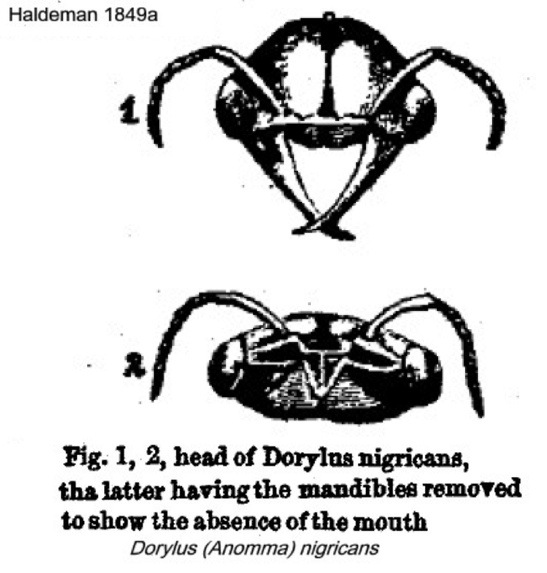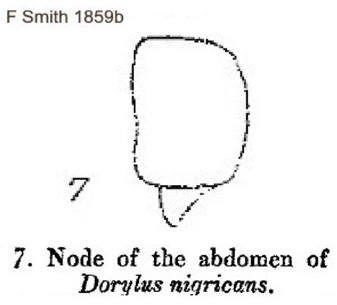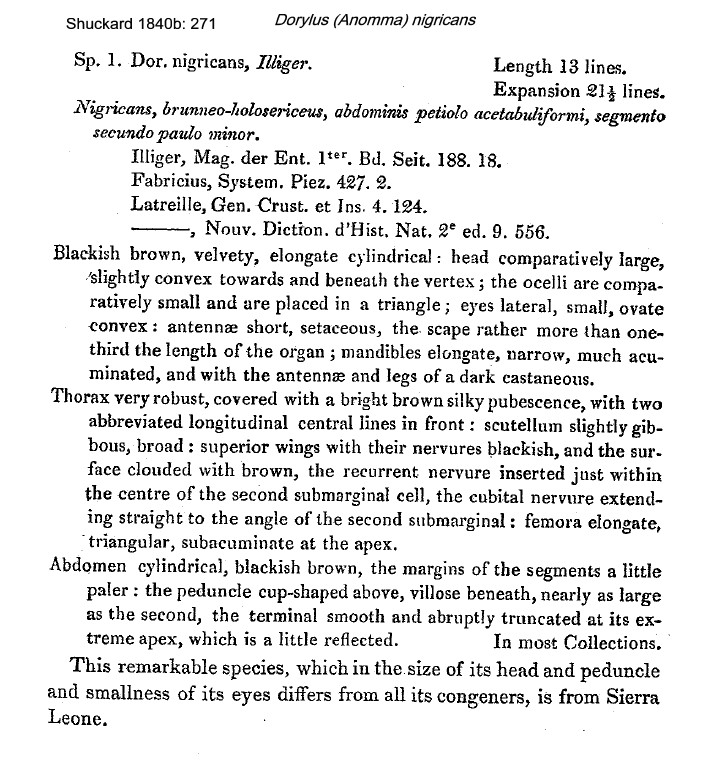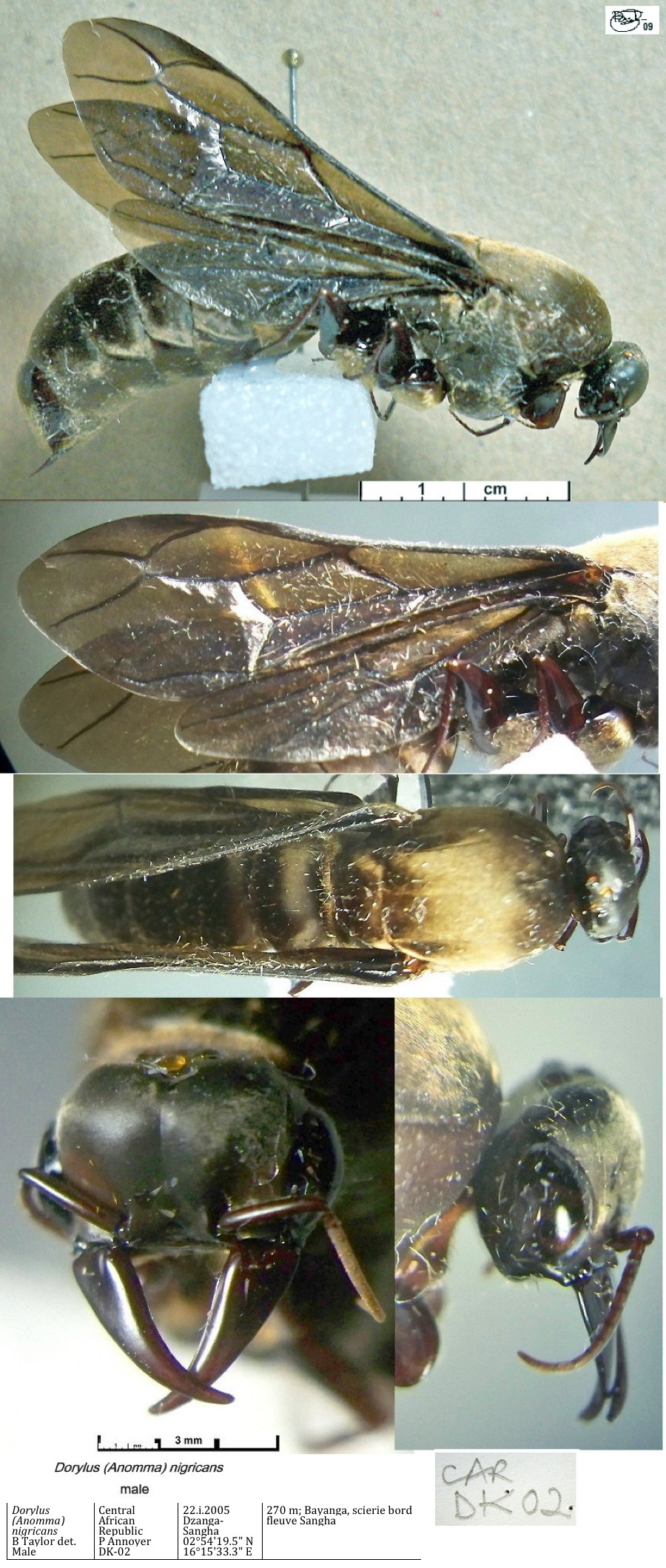Dorylus (Anomma) nigricans Illiger
 Male Male 
 Type location Sierra
Leone (Dorylus nigricans,
Illiger, 1802: 188, male) from a single male specimen, in
Hellwig's collection - type male images not on Antweb (July 2014) Type location Sierra
Leone (Dorylus nigricans,
Illiger, 1802: 188, male) from a single male specimen, in
Hellwig's collection - type male images not on Antweb (July 2014)  . .
|
Illiger's (1802) description is at  . .
Santschi (1930a: 55) described what he regarded as the
soldier & worker of "nigricans" from Mali (Bamakou,
by Andrieu); this is at  .
As with other authors, he did not see either a queen or male and noted
only small differences from burmeisteri soldiers and workers.
He pointed out that nigricans s.s. was
known only from the
male. The availability of type specimens on Antweb (July 2014),
however, show the Santschi specimens to exactly match the Westwood
types of Dorylus (Anomma) arcens. .
As with other authors, he did not see either a queen or male and noted
only small differences from burmeisteri soldiers and workers.
He pointed out that nigricans s.s. was
known only from the
male. The availability of type specimens on Antweb (July 2014),
however, show the Santschi specimens to exactly match the Westwood
types of Dorylus (Anomma) arcens.
What I regard as the probable workers are shown on the Dorylus (Anomma) nigricans
workers page.
|
  Haldeman (1849a)
gave illustrations of the male head and F
Smith (1859) included the petiole profile in a plate comparing Dorylus
males. Haldeman (1849a)
gave illustrations of the male head and F
Smith (1859) included the petiole profile in a plate comparing Dorylus
males.
Raignier & van Boven (1955) cite Illiger's
description as - "Schwärzliche Aemsenwespe [blackish wasp], nigricans,
brunneo-holo-sericeus, abdominis petiolo acetabuliformi. Lange : Einen
Zoll [ca TL 25 mm] bis einen Zoll und drei Linien [TL 28.4 mm]". The
specimen was a little bigger than the already known species Dorylus
(Dorylus) helvolus and without hairs; the wings of nigricans
were smoky black with black veins.
|

Thus, the Illiger, Shuckard, Haldeman, F Smith male
has -
Dark smoky black wings;
The alitrunk dorsum has a shiny brown pubescence;
A steeply domed head, with relatively small eyes and a straight margin
across between the anterior of the compound eyes;
The petiole profile has a shallow curve from the anterior to the
dorsum, the ventral process has a straight anterior at about 45° and
the posterior is convex.
|
Oxford University Museum
specimens |
 The
photomontage is of a male from the Central African Republic,
Bayanga; collector Philippe Annoyer (CAR DK02). . The
photomontage is of a male from the Central African Republic,
Bayanga; collector Philippe Annoyer (CAR DK02). .
The colouration and the velvety appearance matches the
Shuckard (Illiger) description exactly. The head shape matches the
Haldeman drawing. It has a relatively flat occiput, strong median
sulcus, shorter scapes; shorter mandibles; scape length to basal 7.1
segments of funiculus; SL = distance between inner margin of eye and
centre of median ocellus (in full face view scape reaches median
sulcus); eye shorter but just as wide, EW/EL = 79; ocelli set closer
together; from above front of head is concave; posterior margin of
petiole is near flat, with a distinct fringe of hairs; gaster apex,
evenly convex, with prominent stipes extruding.
See a larger
photomontage and a second male from the Central African Republic on the
linked page - Dorylus nigricans
males.
|
The identification by Caspar Schöning of workers (see
the linked page)
as D. nigricans
appears to be a good match to Santschi's description but I presume
that, as Santschi noted, this is as a "most likely candidate" from
comparison with other specimens, e.g. of Dorylus
burmeisteri and Dorylus
arcens. There is, however, on http://www.antweb.org/description.do?rank=species&name=nigricans&genus=dorylus&project=
a set of images of a male accompanied by two sets of worker
specimens. I note, however, that the male shown on Antweb was collected
at a different location in the Tai National Park, at light and not from
a nest. I feel that male is Dorylus
burmeisteri. Those shown as Dorylus
(Anomma) burmeisteri match Emery (1910) - no frontal sulcus,
occiput domed; from above front of head is convex; scape length to
basal 6.3 segments of funiculus; SL = distance between inner margin of
eye and outer edge of median ocellus (in full face view scape does not
reach the faint median line); EW/EL = 71/66; posterior margin of
petiole is shallowly concave; without any fringing hairs (Antweb
specimen from different angle to my two; apex of gaster shallowly
concave, with the stipes barely visible.
|
|